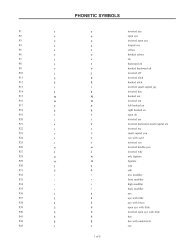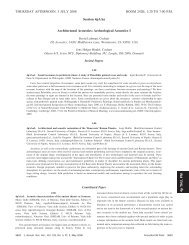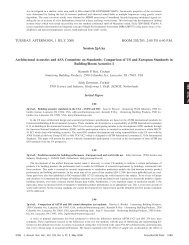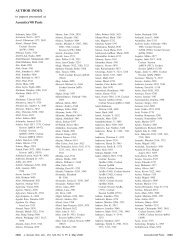Tuesday afternoon, 11 November - The Acoustical Society of America
Tuesday afternoon, 11 November - The Acoustical Society of America
Tuesday afternoon, 11 November - The Acoustical Society of America
You also want an ePaper? Increase the reach of your titles
YUMPU automatically turns print PDFs into web optimized ePapers that Google loves.
not random; rather, they systematically reflect the phonetic implementation<br />
<strong>of</strong> each tonal target. For example, the peak is in the final portion <strong>of</strong> a syllable<br />
in R, and it takes more time for the peak to be fully realized. This<br />
effect can be clearly observed when the following tone is weak.<br />
2pSC27. Investigating the influence <strong>of</strong> context frequency on lexical tone<br />
perception. Jingyuan Huang and Lori Holt Dept. <strong>of</strong> Psych., Carnegie Mellon<br />
Univ., 5000 Forbes Ave., Pittsburgh, PA 15232, jingyuan@andrew.cmu<br />
.edu<br />
Tone languages such as Mandarin use pitch variations to contrast<br />
meaning. Within tone languages, large variability exists in the pitch <strong>of</strong> tones<br />
produced by different speakers. However, previous studies <strong>of</strong> speaker normalization<br />
for contour tones have produced inconsistent results; whether<br />
speakers rely on context information in tone perception is unclear. <strong>The</strong><br />
present study intended to provide an unambiguous test <strong>of</strong> the effect <strong>of</strong> context<br />
on contour lexical tone perception and to explore its underlying mechanisms<br />
and sources <strong>of</strong> information. In four experiments, Mandarin listeners’<br />
perceptions <strong>of</strong> Mandarin first and second level and rising tones were investigated<br />
with preceding speech and nonspeech contexts. Results indicate<br />
that 1 the mean fundamental frequency f0 <strong>of</strong> a preceding sentence affects<br />
the perception <strong>of</strong> contour lexical tones and the effect is spectrally<br />
contrastive: Following a sentence with a higher-frequency mean f0, a following<br />
word is more likely to be perceived as a low-frequency tone and vice<br />
versa; 2 nonspeech precursors also elicit this effect, suggesting general<br />
perceptual rather than articulatory-based mechanisms; 3 listeners can use<br />
information from both fundamental frequency and periodicity to normalize<br />
tone perception. Work supported by NIH NIDCD 2 R01DC004674-04A2.<br />
TUESDAY AFTERNOON, <strong>11</strong> NOVEMBER 2008 LEGENDS 12, 1:55 TO 4:30 P.M.<br />
Session 2pSP<br />
Signal Processing in Acoustics and Underwater Acoustics: Signal Processing for High Clutter Environments<br />
Ronald A. Wagstaff, Cochair<br />
Univ. <strong>of</strong> Mississippi, Natl. Ctr. for Physical Acoustics, 1 Coliseum Dr., University, MS 38677<br />
Joal Newcomb, Cochair<br />
NAVOCEANO, 1002 Balch Blvd., Stennis Space Center, MS 39522-5001<br />
Chair’s Introduction—1:55<br />
Invited Papers<br />
2:00<br />
2pSP1. Signal processor for detection <strong>of</strong> signals in cluttered environments. Ronald Wagstaff and Heath Rice NCPA, Univ. <strong>of</strong> Mississippi,<br />
1 Coliseum Dr., University, MS 38677, rwagstaf@olemiss.edu<br />
<strong>The</strong> well-publicized experience <strong>of</strong> the USS Cole in a foreign port demonstrates the potential danger our military ships are frequently<br />
exposed to. When docked, they are the most vulnerable to attack by small fast boats that can hit and run before their threat is recognized,<br />
and defenses can be activated. This is a challenge that has many facets. Attack by a small high-powered fast-boat is just one type <strong>of</strong><br />
threat. However, it is important. One way <strong>of</strong> quickly identifying a fast-boat is with an underwater acoustic sensing system. Such a<br />
system is not without challenges. Harbors are typically busy and contaminated by many forms <strong>of</strong> acoustic clutter. Detecting and separating<br />
the signals <strong>of</strong> fast-boats from among the clutter are difficult tasks. Fortunately, a signal processor has been developed with highly<br />
coherent fast-boat signals, and harbor clutter in mind. This fast-boat processor invokes temporal coherence constraints, by degree, to<br />
strip away incoherent noise and less coherent shipping signals, and leaves the fast-boat signals exposed. This signal processor will be<br />
discussed, and the results will be presented to illustrate the substantial signal-to-noise ratio and automatic signal detection gains that can<br />
be achieved.<br />
2:20<br />
2pSP2. Human detection algorithm for seismic and ultrasonic detectors. Alexander E. Ekimov and James M. Sabatier NCPA, Univ.<br />
<strong>of</strong> Mississippi, 1 Coliseum Dr., University, MS 38677<br />
Range detection methodologies for human acoustic signals are discussed. Seismic, passive, and active Doppler ultrasonic sensors are<br />
used in the presented methods. <strong>The</strong> algorithm developed for recognition <strong>of</strong> human’s presence in the measured signals is based on detection<br />
<strong>of</strong> the specific acoustic signatures resulting from specific human motion characteristics. <strong>The</strong>se signatures have two characteristic<br />
times, T1 the footstep repetition time, which is equal to the time <strong>of</strong> the whole body periodic motion and T2 the footstep duration<br />
time. <strong>The</strong> footstep duration time is equal to the time interval for a single footstep from “heel strike” to “toe slap and weight transfer.”<br />
Taking advantage <strong>of</strong> these times in signal processing for optimization <strong>of</strong> the signal-to-noise ratio and applying a procedure <strong>of</strong> cadence<br />
frequency detection allow recognition <strong>of</strong> human presence in the analyzed signals. This algorithm was tested and it was experimentally<br />
demonstrated that cadence frequencies for walking human and their harmonics for seismic and ultrasonic signatures passive and active<br />
Doppler signatures were the same. Cadence frequencies were stable and had no detectable variation in time for a regular walking style.<br />
This stability feature potentially may be used for human tracking. Work supported by the Department <strong>of</strong> the Army, Army Research<br />
Office, Contract No. W9<strong>11</strong>NF-04-1-0190.<br />
2499 J. Acoust. Soc. Am., Vol. 124, No. 4, Pt. 2, October 2008 156th Meeting: <strong>Acoustical</strong> <strong>Society</strong> <strong>of</strong> <strong>America</strong><br />
2499<br />
2p TUE. PM







